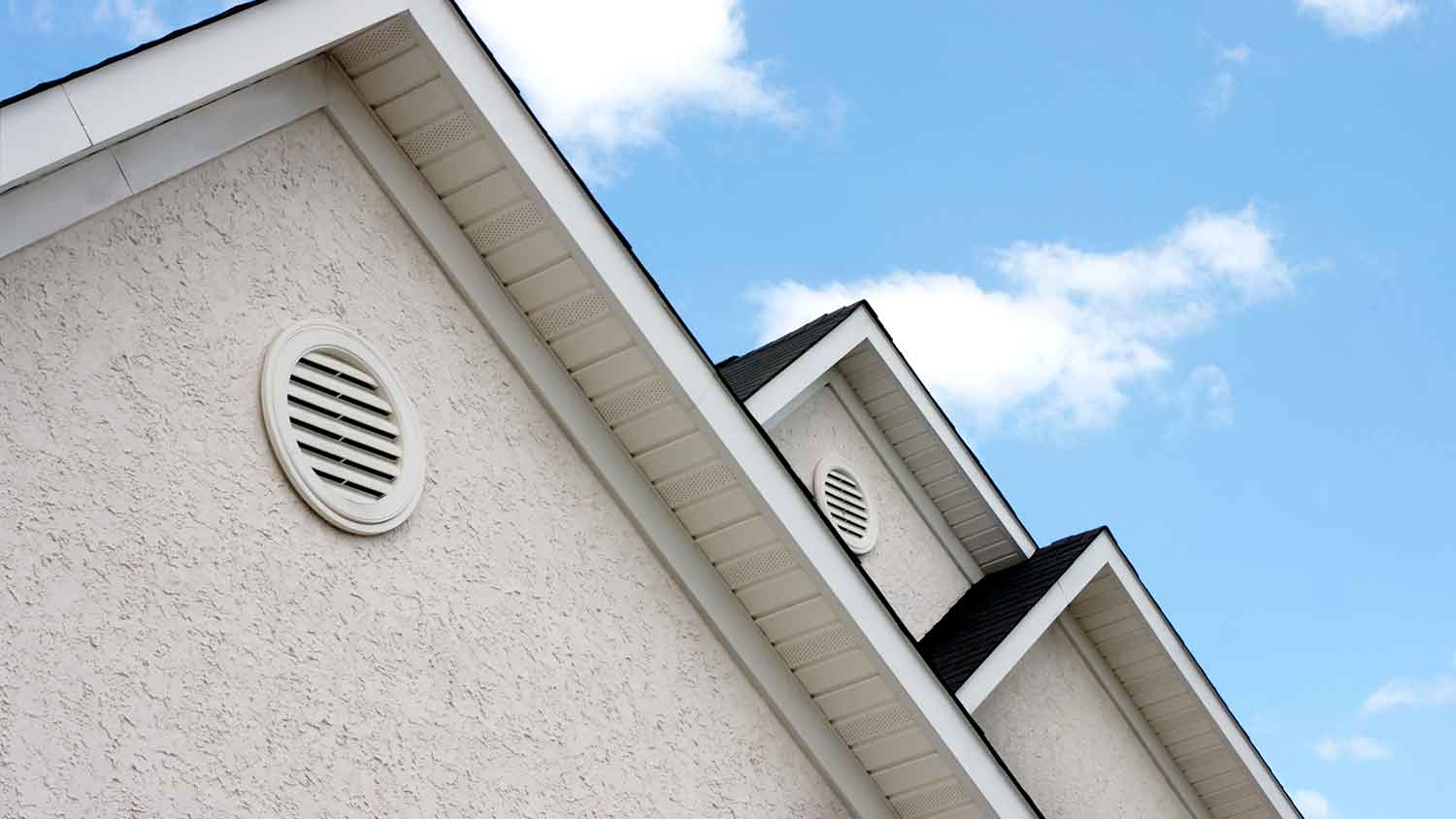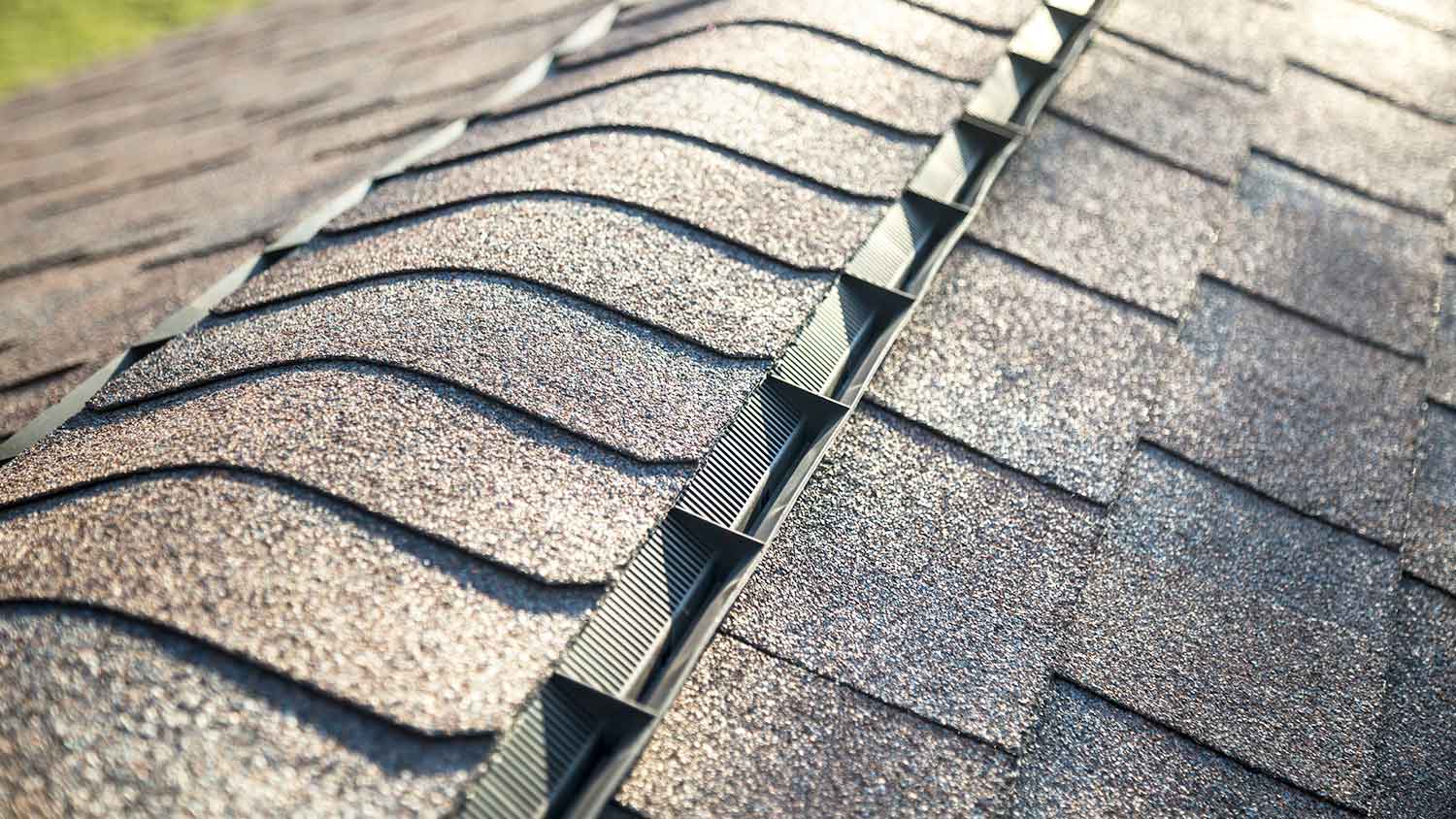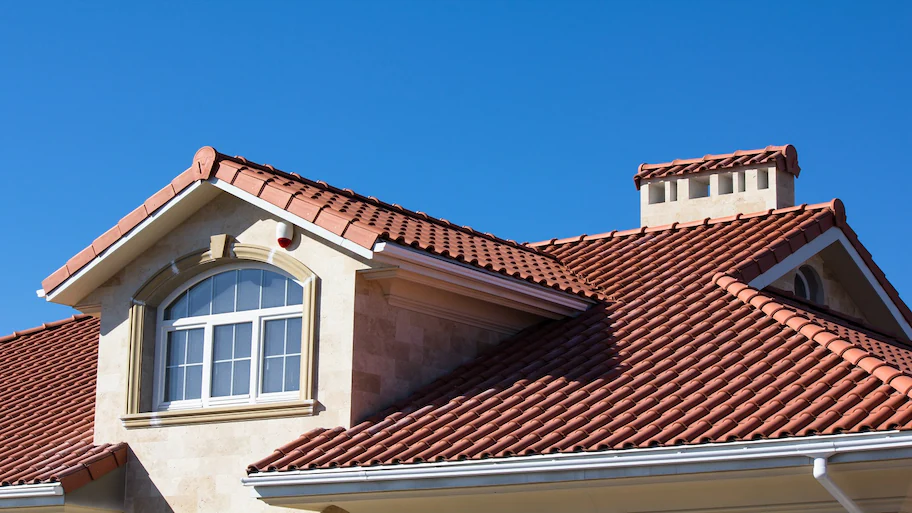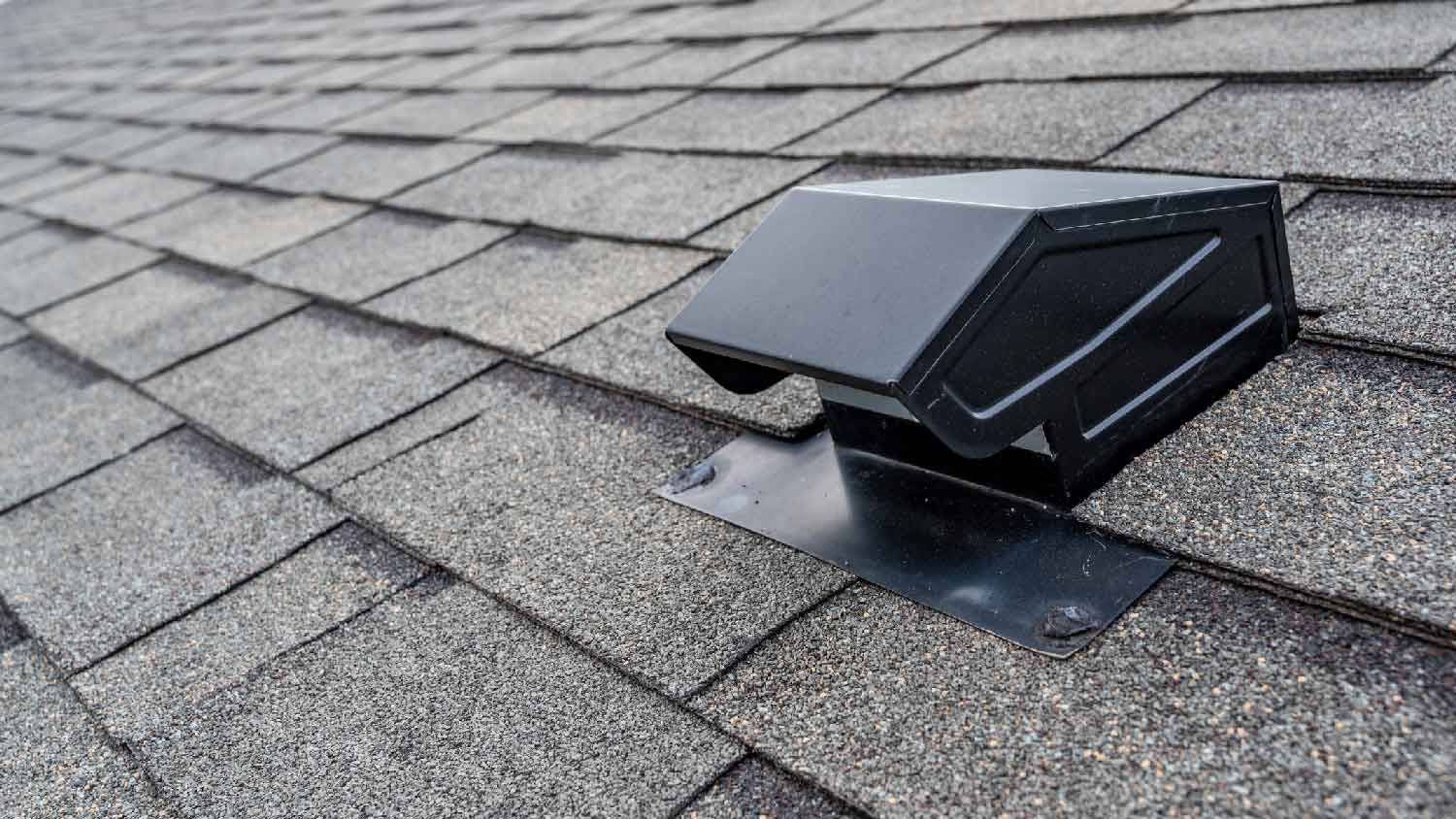
Soffit replacement costs depend on multiple factors, like length, accessibility, and material. Learn about the cost factors to budget more accurately.
Go with the airflow


Gable vents and ridge vents are both passive roof ventilation systems.
Gable vents have a more traditional appearance.
Ridge vents are more expensive but boast better durability.
Proper airflow in your attic is crucial for ventilation, which keeps moisture problems at bay. Homes require a roof vent that does the job well, and many homeowners weigh their options between a gable vent versus a ridge vent. Learn the benefits and drawbacks of each type to make your decision a breeze.
While both gable vents and ridge vents create a well-ventilated roof, they have some important differences. Gable vents are located near the roof peak on the gable ends of a house and allow hot air to escape, promoting airflow within the attic space. Ridge vents are installed along the roof's peak and work by creating a continuous ventilation system that allows hot air to rise and exit the attic while drawing in cooler air from the soffit vents.
While gable vents deliver more localized ventilation, ridge vents offer a more efficient and continuous airflow throughout the attic.

Gable vents are a type of passive ventilation system installed near the peak of the gable ends of a roof, often a gable roof. Their job is to get rid of hot, stagnant attic air and replace it with cooler, fresh outside air. Gable vent openings are covered with slats to keep pests and debris out while allowing air to flow freely in the attic. This helps regulate temperatures, reduce moisture buildup, and extend the life span of your roof and insulation.
| Pros | Cons |
|---|---|
| Effective ventilation | Limited coverage |
| Simple installation | Ineffective in high wind conditions |
| Enhances roof's life span | Required maintenance |
| Aesthetically appealing | Potential for pest entry |
Best for:
Homes with traditional architectural styles, such as colonial, Victorian, or cottage-style houses.
Moderate climates where extreme weather conditions are less common.
Gable vents do what they promise—they ventilate your attic space, regulate temperatures, and prevent mold by reducing moisture. Gable vents also add aesthetic appeal to a home's exterior. Available in various designs and styles, they can complement your home's architectural design.
Another upside to a gable vent is its simplicity and price tag. These vents are relatively easy to install and cost less than a ridge vent.
A drawback of a gable vent is that its placement on the gable ends of a roof can cause uneven airflow distribution and poor ventilation in your attic.
High winds and heavy rain are challenging for gable vents because water can seep into the attic through the slats and put your home at risk of moisture damage.
Gable vents also require regular maintenance to keep them in good shape. Leaves, dust, or bird nests can block airflow, so you should inspect your vents regularly and clean them when needed. But even with regular cleanings, small critters and bugs may find their way into your attic through gable vents, leading to an infestation if left unchecked.

Ridge vents are installed along the peak of a roof to allow continuous airflow between the attic space and the outdoors. They have a narrow, low-profile vent that runs along the length of the roof ridge, often covered with a weather-resistant material.
A passive type of vent, ridge vents use natural convection to draw hot air out of the attic while allowing cooler air to enter through soffit vents under the eaves. This continuous airflow helps regulate attic temperature, reduce moisture buildup, and prevent damage to roofing materials and insulation.
| Pros | Cons |
|---|---|
| Continuous ventilation | High initial cost |
| Weather resistant | Compatibility issues |
| Low maintenance | Risk of water infiltration |
| Aesthetically pleasing | Potential for pest entry |
Best for:
Roofs with moderate to steep pitches.
Homes in regions prone to severe weather.
Attics that are used as a living space.
Many homeowners appreciate ridge vents' ability to provide continuous airflow throughout their attic. How much ventilation an attic needs depends on how you use the space. Still, consistent ventilation reduces attic temperatures and helps decrease the workload on air conditioning systems, leading to potential energy savings.
Another perk of ridge vents is that they're highly durable and weather-resistant, capable of withstanding strong winds, heavy rain, and snow without compromising their functionality. Their low-profile design seamlessly blends with the roofline, enhancing your home's curb appeal. Ridge vents don't need much maintenance, as they are less prone to debris accumulation compared to other types of vents, reducing the need for regular cleaning and upkeep.
Ridge vents cost more upfront compared to other ventilation options since they require more labor and materials. This is especially true for homes without existing ridge vent systems. Ridge vents cost between $300 and $650, while other types of roof vents range between $60 and $250. When comparing a ridge vent versus turbine, the latter is more similarly priced to a gable vent.
Another drawback of ridge vents is that they won't work for every type of roof. This incompatibility can decrease ventilation, especially in homes without enough soffit ventilation or obstructed airflow.
There is also some risk of water infiltration if ridge vents are improperly installed or damaged. This could become an issue during heavy rain or snow, potentially leading to water damage within the attic and inside your home. Ridge vents are designed to prevent pest entry, but small animals or insects can still find their way into the attic through the vent openings, though regular inspection and maintenance should stave off infestations.
Most homeowners find that ridge vents have a better aesthetic appeal compared to gable vents. Ridge vents have a low-profile design that blends seamlessly with the roofline, maintaining the architectural integrity of the home's exterior. While some prefer gable vents, this type of roof vent can sometimes disrupt the visual harmony of the roof by protruding from the gable ends.
Gable vents offer more variety and flexibility and come in various designs, sizes, and materials. This variety allows homeowners to choose options that complement their home's architectural style and personal preferences. Ridge vents are more standardized in design and placement, offering fewer customization options.
The location of ridge vents along the peak of the roof makes it more durable. Ridge vents are also made from stronger materials and are less prone to damage from weather or impacts. Gable vents tend to be more exposed and prone to damage.
Gable vents are a more cost-effective venting option, with the average price ranging between $60 to $150 per unit. Ridge vents are much more expensive, costing between $300 to $650 per unit.
Gable vents require basic tools and straightforward installation methods. In most cases, a roofer near you can simply cut an opening in the gable end and secure the vent. Ridge vents require more labor and expertise for proper placement along the entire length of the roof ridge, which can be more time-consuming and complex, especially for homes without existing ridge vent systems. It’s important to know how to choose a roofer that can handle complicated ridge vents before starting your project.
A gable vent's location is more accessible on the home's exterior, allowing for easier repairs if necessary. Ridge vents can be more challenging to access and repair, often requiring more extensive efforts and specialized equipment.
While both ridge vents and gable vents are easy to maintain, gable vents hold a slight edge based on their location. Because gable vents tend to be easier to access, performing maintenance tasks is simpler.
Ridge vents may offer a slight resale advantage over gable vents. Ridge vents are often considered a more modern and efficient ventilation solution, which could enhance a home's overall appeal to potential buyers.
From average costs to expert advice, get all the answers you need to get your job done.

Soffit replacement costs depend on multiple factors, like length, accessibility, and material. Learn about the cost factors to budget more accurately.

Getting a wind mitigation inspection can work in your financial favor. Learn about the average wind mitigation inspection cost, including ways to save.

A new roof improves curb appeal, increases home value and keeps your living space protected from the elements. Learn about average roof replacement costs to set your budget.

Sharpen your skills and smooth your cuts with this DIY guide to cutting metal roofing. We cover everything from measurements and safety gear to which tools will give you the cleanest cut.

There is a calculation for how many soffit vents you need, depending on your square footage. Discover where to install them and what happens to your attic air during winter.

This guide lays out the cost to install a roof vent on your home depending on the type of ventilation that's best for your roof based on several factors.